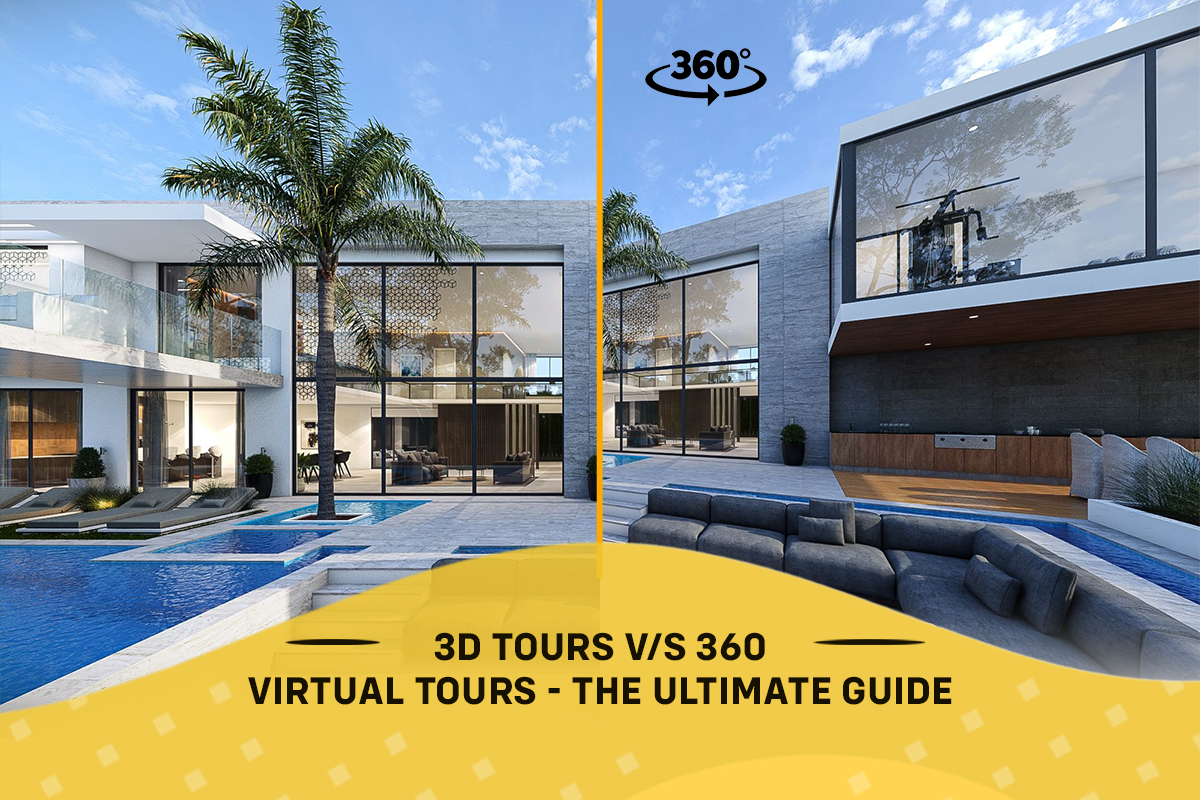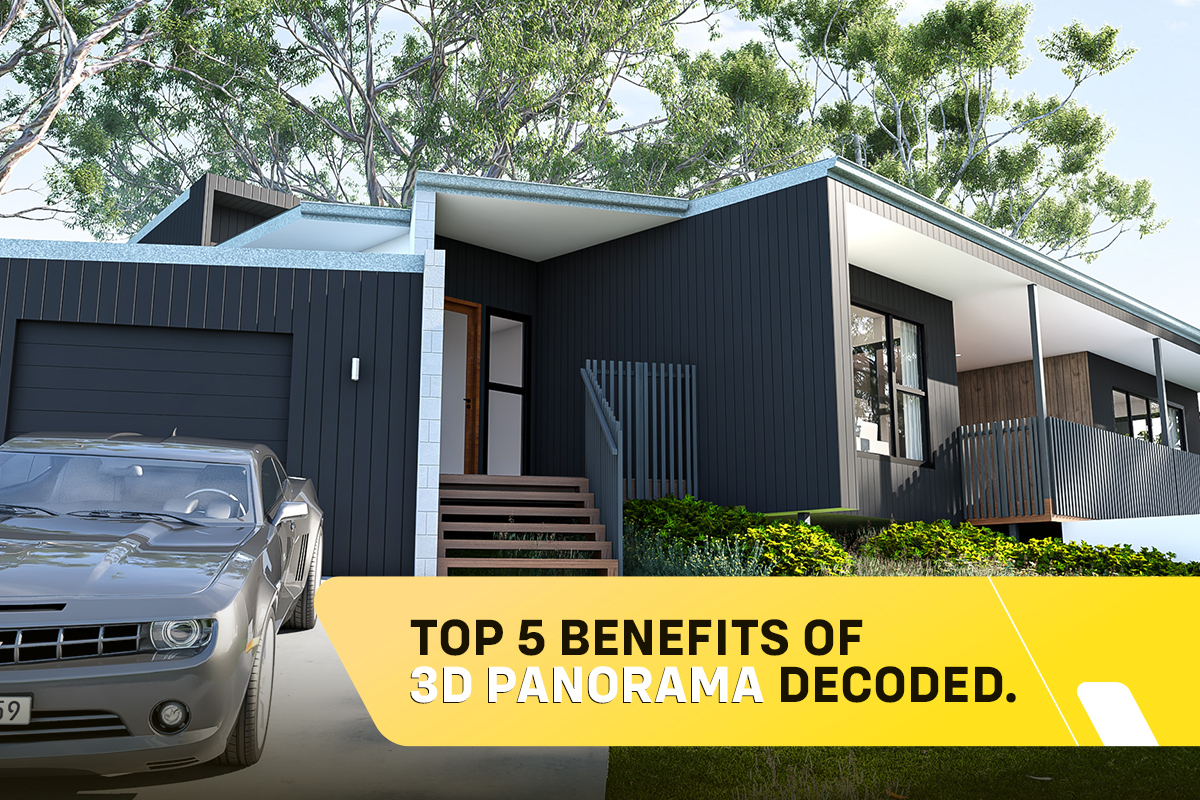Virtual reality is the driving force of technology taking us into the future. It’s no longer just the ambiguous piece of technology found in sci-fi novels and movies. VR is real (no pun intended), and here to stay.
Virtual reality (VR) is inextricably related to many facets of our lives, from video games to culture, art, and education. It’s a somewhat outlandish concept – you put on a VR headset and you can take 3D virtual tours of an entirely different environment with which you can interact as if it were the physical environment.
And when you finally grasp its potential, you start thinking of all the possible capabilities of this technology. Moreover, you cannot help but consider the immense impact virtual reality is likely to have on the very essence of human interaction.
Today, let’s focus our attention on the differences between VR technology made for the architectural and real estate sphere, 3D tours and 360 virtual tours. We start with 3D tours:
What are 3D Tours?
3D virtual tours, often known as 3D Panoramas, enable real estate brokers to elaborately present intricate environments and features of a home. It provides a 360-degree perspective of a property using computer-generated imagery. It may also be applied to both already constructed and unfinished properties.
3D virtual tours enable both realtors and potential purchasers to see how a house would seem unfurnished or with their preferred furnishings and accessories. This technology allows users to fully engage with a house and go beyond a simple 360 virtual tour. This allows prospective buyers to fully immerse themselves in the digital environment with features that allow them to open and close doors, arrange furniture, and even explore rooms in more detail by zooming in and out.
Let’s take a look at some definitive benefits of 3D virtual tours:
Benefits of 3D Virtual Tours
Besides being a safer, more practical option in this day and age, 3D virtual tours have several other advantages, including the following:
Save Time & Money
3D virtual tours save real estate agents hours every week by reducing the need to visit house after property and wait on doorsteps for clients to come. The same is true for prospective purchasers, who can study a detailed representation of a property from the comfort of their homes prior to visiting it in person.
Provide a Realistic Experience
Prospective buyers can explore the property in greater detail with the use of 3D virtual tours. It facilitates their ability to imagine what life might be like in that space.
Boost Web Traffic Rate
Using this cutting-edge technology helps your real estate company draw in more clients. Especially with the help of streaming services that make these 3D virtual tours accessible to all devices, anywhere, and at any time. This can immediately boost your website traffic as well as conversion rate.
Edge Over Competitors
Real estate agents can employ this technology and get an edge over their competitors in this near-saturated industry. Moreover, the next generation of home buyers and renters are way more technologically inclined than ever before, and almost expect companies to keep up with the latest advancements in the industry.
Now, we’ve talked quite a bit about 3D virtual tours and all that it entails. But there is another technology out there that is quite similar to 3D virtual tours and has its use in the same sphere of real estate marketing. It’s called 360 virtual tours.
Without wasting any time…
What are 360 Virtual Tours?
360 virtual tours are developed by essentially stitching together multiple 360-degree photographs captured at a property. 360 virtual tours, which are often used for already-built properties, offer a more static view of a property. Viewers can spin in any direction and move between rooms just as in 3D virtual tours, but with limited functionality.
Despite these limited functionalities, a 360 virtual tour is nonetheless an interactive way to explore a property.
Now that we have a much clearer render (picture) of 3D tours as well as 360 virtual tours, let’s take a more subjective view and pit them directly against one another.
3D Tours vs 360 Virtual Tours
A 3D virtual tour provides a more accurate impression of the scale and perspective of a property than a 360 tour. It allows viewers to get a better sense of a home’s size and dimensions by looking at both its interior and exterior.
360 virtual tours, on the other hand, use static photos to provide a more panoramic view of a location. This creates the illusion that viewers are viewing a spherical image. Because 360 tours are photographs stitched together, they naturally present a more realistic environment but do not allow for in-scene interaction.
Which virtual tour you choose to use will be largely influenced by the project and property at hand. 3D virtual tours provide several benefits for new homes. Property developers have a clear competitive edge since they can start marketing a development months before it is really built.
3D virtual tours are significantly more adaptable because they may be utilized for both constructed and unconstructed locations. Tour designers can gather information from the property’s development team in order to build a 3D rendering of the space, without having to enter the actual property. This technology can even be applied to properties that are still under construction, making it simpler for developers to picture the finished product.
Real estate agents, developers, and potential buyers can all make better, more educated judgments when they can see a location through realistic 3D rendering. The best part is that these interactive 3D tours may be enjoyed from the ease and safety of one’s home.
Which one should you go for?
3D virtual tours seem to be the more versatile and functional option. But rendering one is just as expensive and complicated. So deciding which direction to go in for your specific case is not as straightforward. There are also certain considerations to be made. Here are some of them:
-
What is your client’s preference?
Of course, this is what it all comes down to. What your client wants. If they have a clear direction they want to go in, great! But often, your client may not be sure what exactly it is that would appease them or convince them to make a decision one way or another.
3D virtual tours will allow your visitors to better understand the dimensions. They can simply look up and be incited with strong sensations of magnanimity by just experiencing the height of the ceiling.
However, sometimes you don’t need to arouse those reactions in your audience. Perhaps all you’re attempting to do is stand out from the online sea of images and videos. If that’s the case, a 360-degree virtual tour might just be enough for you.
-
How much information does the viewer need?
If your client is building a restaurant, then the need of the hour might be to simply showcase the vibe and the ambiance of the place to potential future patrons. A 360 virtual tour on the restaurant’s website may work really well for enticing people to the eatery. A 3D tour may be a bit redundant in this case, especially given the time and money costs it comes with.
On the other hand, an office complex being built might have a more pressing need to showcase the exact dimensions of the space in a more interactive manner. This is where 3D tours can shine, and 360 tours may not be as useful.
-
Finally, what are the time and money constraints?
360-degree tours are the easiest to create and cost the least to produce. Simply submit your images, tag them with supplementary material, and indicate which rooms they belong to. It should just take you a few minutes or hours to design one, depending on how large your tour is.
In contrast, creating 3D tours take longer and cost more money. Even the software needed to render such a walkthrough has a steep learning curve.
Consult with your clients about all the potential benefits and features of both 360 tours and 3D virtual tours. Then let them make the decision based on the potential values to be derived from each of the endeavours.
So there we have it. A complete rundown of 3D virtual tours and 360 virtual tours. We hope this guide helps you make the right choice for your next project.
Speaking of the right choices, when it comes to 3D renders, Australia chooses the reliable option – Render Visuals. We deliver a wide range of 3D rendering services including 3D virtual tours for the property market, to help bring your clients’ dream projects to life. Connect with us at www.rendervisuals.com.au or reach us at info@rendervisuals.com.au or +61 -406822061/ 488805395 to know more!


